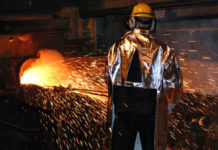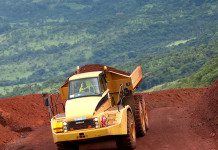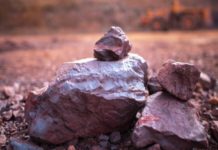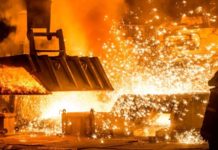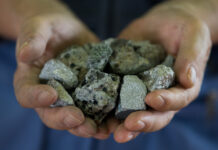
[miningmx.com] – SOMEWHERE, quite high up on the list of pretty good
ideas over the last 40,000 years, must be steel. Every modern society needs it. Yet
the reality is that most companies making it today are losing money. In the case of
ArcelorMittal South Africa (Amsa), South Africa’s biggest steelmaker, life couldn’t be
more difficult.
Amsa’s share price is at its lowest since 2005 and the troubling news from the
company’s CEO, Nonkululeko Nyembezi-Heita, is that she can’t tell when trading
conditions in the global steel industry will improve. On top of that, elements within the
South African government are waging a cold war against Amsa, believing that it over-
charges for its steel.
Amsa also has one of the busiest legal teams in corporate South Africa. The company
is fighting a series of anti-competitive actions lodged with the government’s
Competition Commission, while it’s also locked in a dizzyingly complicated battle
involving Anglo American over the cost of iron ore supplied to it by Anglo’s listed
subsidiary, Kumba Iron Ore (Kumba).
Managing these pressures can’t be easy for Nyembezi-Heita, who, on occasion, has
been cast as the pantomime villain; at other times, the marionette of Luxembourg,
the sleepy (but monied) European duchy where parent company ArcelorMittal is
headquartered. Critics have even accused Nyembezi-Heita and her team of
incompetence. Yet, after four-and-a-half years at the helm, in which time she is not a
little battle-scarred, Nyembezi-Heita cuts a forthright figure; undimmed would be the
word.
BATTLE-SCARRED
Wouldn’t it have been more fun to stay among the likes of Vodacom, or in the world
of financial services such as Alliance Capital, both former employers of Nyembezi-
Heita? “It’s the challenge,’ she says of Amsa, and adds that she enjoys the company’s
position in SA’s infrastructure story. She’s less enthusiastic about the glamour of being
a CEO, however. “I don’t do profiles,’ she says. Being a CEO is “just a cog in the
machine’.
Really? Well, perhaps a pretty important cog. “Now and again, you get decisions
where you decide the direction of company,’ says Nyembezi-Heita. Generally, though,
Amsa is a team effort, although it depends what you mean by “team’. A frequently
posed question of Amsa is whether the key decisions are made by the owner, Lakshmi
Mittal & Family, who reside in Europe and don’t have South Africa’s “national interest’
at heart.
There is certainly a degree of distrust of the Mittal family. This probably dates from
the first time the family’s LNM seized a stake in Ispat Iscor in 2004. Its business
assistance programme, which Iscor said at the time had saved it R388m, stuck in the
craw because the family earned fees for money saved even though it was a
shareholder. Since then, the Mittal family’s activities in South Africa have been viewed
with caution.
Says Nyembezi-Heita on the relationship with ArcelorMittal: “We have a local board
that carries out its fiduciary responsibility. The group (ArcelorMittal) has
commensurate representation. They provide input, the board decides and then it signs
off. It’s an easy working relationship.’
Less easy to manage is the relationship with the South African government.
Nyembezi-Heita concedes that there’s “a difference of opinion’ between the trade and
industry department (DTI) and Amsa on steel pricing. But the DTI isn’t the only voice
in the government, and therein lies the difficulty of pinning down the kinds of
challenges that Amsa faces from the state, especially as Government wrestles with
future economic policy.
On the one side, there’s the recently published second and final draft of the National
Development Plan, which sets infrastructure as an important national deliverable, a
document Nyembezi-Heita welcomes as an important voice in the economic growth
debate. On the other is the ANC-commissioned State Intervention in Mining (Sims)
report, which is intended to shape an industrial policy in such a way that it supports
developmental outcomes. Sims also captures a view that Amsa should be levered into
selling steel domestically at EPP or export price parity prices.
“There is an urgent need to faciliate the establishment of a new steel operator that
would sell steel into the local market at EPP,’ say the authors of Sims. They suggest
the creation of a state-owned 3 million tonne/year (Mtpa) to 5Mtpa steel producer that
would sell domestic steel at EPP and consequently force Amsa to drop its domestic
steel prices.
Says Nyembezi-Heita: “Under conditions of EPP, could you expect a sustainable
industry? There is no place to contemplate a wholesale drop in steel prices. In a
market like today, everyone is in survival mode.’ She adds that if Amsa couldn’t
make money, it would have to review its operations which currently supply about 70%
of SA’s flat products and the majority of long products. Strong stuff.
ANALYSTS CRITICAL
Talking of survival mode, the company has since the beginning of 2009 lurched in and
out of profitability on a quarterly basis; reporting negative earnings for the first three
quarters of 2009; making money for the next four; and then, over the remaining
seven quarters, reporting negative earnings in four of them.
“The current situation with Amsa is not one of an epic fail,’ says Paul Theron, of asset
manager Vestact. “It’s just a normalisation of the share, given the crappy place it has
in the earnings cycle currently,’ he says. There’s noise, too, in the stock. Technical
problems at its plants, questions about the vigilence of its legal titles department, and
the fight with Kumba Iron Ore all sit on the share. Vestact doesn’t hold shares in
Amsa.
“They’ve lost their way,’ said Adrian Saville, chief investment officer at Cannon Asset
Management. “They’ve gone from a position of strength [in the Fifa World Cup inspired
infrastructure build bubble] to one of weakness. And the problem is, it’s hard to see a
catalyst that will change things. It feels a bit like SAA (the indebted and failing
national airline).’
Cannon Asset Management doesn’t own shares in Amsa either, but one shareholder,
Stanlib Asset Management, also has reservations about the stock. “I suppose there’s a
case for value investors seeing in Amsa a reversion to mean. But there are
headwinds,’ says Stanlib’s Sholto Dolamo. “One is the developmental scenario of
government in steel pricing. But Amsa has also lost its competitivness opening up for
imports now. The door has opened,’ he says.
Nyembezi-Heita acknowledges the competitivness of South Africa, or lack of it, has
become an issue, largely owing to the cost of electricity. In addition, the cost of raw
material inputs to steel fabrication, such as iron ore and coking coal, have also risen
at a rate out of whack with increases in steel products such as hot rolled coil.
Consequently, global margins have shrunk from 45% in 2005 to 15% in 2010 to 10%
this year. ArcelorMittal has closed plants in France and Germany amid a contraction in
global demand growth to 4% at the most, from a possible 5%, and the relegation of
the company’s debt to junk status. Thyssenkrupp is also cutting back. So are many
other steelmakers.
No one company is exempt from the margin pressure. Tata Steel, the $6.7bn Indian
firm, recently posted an 89% decline in first quarter earnings. According to the China
Iron and Steel Association, the country’s steelmakers reported an aggregate profit
plunge of 96% in the first half of the year, a statistic reported by the Wall Street
Journal.
“We have different realities,’ says Nyembezi-Heita of the government’s perspective
and agrees that both are looking for votes, be they shareholders or the electorate. But
there appears to be no softening in Amsa’s stance on pricing. Strategically, South
Africa is too important to give up on. Nyembezi-Heita says the attitude in Luxembourg
is that South Africa represents the seeding ground of the last great developing
economy: Africa.
Europe and the US have peaked in steel demand growth, while ArcelorMittal hasn’t a
footprint in Asia, including India. It’s made inroads into South American (Brazil), but
Africa will be “the last region to experience major consumption growth on a steel per
capita basis,’ says Nyembezi-Heita. “It’s a patient game,’ she adds. “Locally, we take
a somewhat shorter term view of things.’
KUMBA IRON ORE
Like a new interim pricing arrangement with Kumba?
This is the amount Amsa is to pay for iron ore that used to be supplied on a cost plus
basis; in other words, a heavy discount to internationally traded iron ore prices. The
story of Amsa’s tussle with Kumba is becoming part of corporate and legal lore in
South Africa, a series of events that stretches over an epic four years. You may know
the story. If not, here’s the briefest of summaries.
Kumba said the cost plus iron ore supply agreement had lapsed because it thought
Amsa had failed to renew its share of Sishen Iron Ore Company (SIOC) mining
licence. The matter was eventually settled in the High Court, when it was decided that
Kumba had 100% of the mining rights when it had met empowerment laws and
converted to new order mining licences in terms of 2004 mining legislation.
Still, Kumba has used the situation to insist discounted iron ore to Amsa, predicated
from when the two companies were housed in Iscor, can’t continue. Nyembezi-Heita
thinks a reversion to a cost plus arrangement is the likelihood when the matter goes
to arbitration next year, although a new interim pricing deal is proving difficult to
agree. As a result, the DTI is to appoint an arbiter while the old interim pricing deal
rolls over for the remainder of the year.
Looking back, the contest with Kumba, which also brought us the controversial
Imperial Crown Trading (ICT), a politically-connected company that thought it too
owned part of Sishen, couldn’t have been avoided, says Nyembezi-Heita. “When Chris
(Griffith, CEO of Kumba) first sat down, we thought we could see eye-to-eye pretty
quickly,’ she says, smiling. “Famous last words.’
Further disputes with Kumba appear likely. One is over another iron ore project called
Phoenix, from which Amsa withdrew in 2005 but now claims must supply it with
lower-than-market-price iron ore. It seems contentious to claim this, but Nyembezi-
Heita says the debate has similarities to the SIOC matter but differs in that it’s a
question about whether the Thabazimbi supply agreement applies to the Phoenix
project.
“It’s a difficult environment for both companies and I don’t want to demonize Kumba,’
says Nyembezi-Heita. “But you have to protect the company’s position.’
If this weren’t enough, there are the claims that the Competition Commission is
investigating. They all turn on the allegation that Amsa is guilty of pricing abuses.
“Deep down,’ says Nyembezi-Heita, “there are probably elements in the Competition
Commission who believe Amsa, and the steelmaking industry in general, has a “deep
rot’’ as she terms it. Amsa overturned on appeal the Competition Tribunal’s guilty
verdict on excessive pricing, a case brought by DRDGold and Harmony Gold from
about 2005. “So there was this enduring belief that pricing was too high,’ she says.
The latest Competition Commission suit is a rather interesting test case of “conscious
parallelism’, where competitor Evraz Highveld allegedly followed price increases
installed by Amsa. Isn’t that capitalism, though? Nyembezi-Heita agrees, but it’s now
the demesne of the lawyers, one she said earlier in the year they were enjoying,
given the premise of the suit was so novel.
Ultimately, Amsa’s needs might be better served in respect of raw materials by
seeking backward integration. There are plans to build its own iron ore mines. Amsa
owns an as-yet-unnamed iron ore mine in the Northern Cape and has a 50:50
agreement with Kumba on the Zandrivierspoort prospect in the Limpopo province, but
Nyembezi-Heita says that securing the resources in terms of availability is
“constrained’, owing to the scarcity of the resources generally.






